Autumn 2023
News from the Top
Board Changes
A few changes in organization leadership have occurred since the July conference. We’ve filled two soon-to-be vacant board positions, with terms starting next February. Steve Ditmars will become Vice President and Colin Conway, Secretary. Kelli Peacock has become our Treasurer, and Vicki Weisfeld has taken over Kelli’s role as newsletter editor. Board members voted to increase the board’s membership to eight, by adding the conference coordinator, the writing competition coordinator, the IT coordinator, and newsletter editor to the four existing positions (President, Vice President, Secretary, Treasurer). In addition, Marilyn Meredith remains member-at-large. Here are the quarterly reports from our President, Treasurer, writing competition coordinator, and conference coordinator.
President’s Report – John Schembra
 Greetings PSWA members! Well, it’s been almost two months since the 2023 conference ended. Another stellar event enjoyed by all, from what I saw and heard from members (more below in Mike’s report). Again, I cannot thank the board members enough for their work in advance and at the meeting. Special thanks to those who sponsored the coffee services.
Greetings PSWA members! Well, it’s been almost two months since the 2023 conference ended. Another stellar event enjoyed by all, from what I saw and heard from members (more below in Mike’s report). Again, I cannot thank the board members enough for their work in advance and at the meeting. Special thanks to those who sponsored the coffee services.
I was very happy to see several new members/first timers at the conference and was so glad many were able to garner the coveted “Award Winning Author” status. Congratulations to all the award winners, listed on our webpage www.policewriter.com.
Conference innovations in 2023 included moving the writing competition awards to Saturday night, which appeared to work well (more below in Barbara’s report). We also established the Marilyn Meredith Award for Excellence in Published Book-Length Fiction and in Published Book-Length Non-Fiction, presented to the works receiving the highest scores from the judges in those two categories. Winners of this inaugural award were James L’Etoile for his novel, Dead Drop, and William Soldato for his non-fiction work, Under Too Long. The conference also included 14 prize drawings, with the grand prize a free registration to next year’s conference. We plan to make the drawings an every-year event.
In addition to the board member changes noted at the head of this article, others are coming up. After five years’ service, I will be stepping down as President (new grandchild and an impending permanent move to North Carolina). RJ Beam, our current Vice President, has agreed to become the next president. With “retirement” in mind, I want to thank all the PSWA members for their support and friendship, with special thanks to the following:
My personal thanks go to Keith Bettinger for his many years of service as a board member, lately as our Secretary. Even though it was tough on him to do so (and to let us store all our gear in his garage!), he served without complaint. Keith, a multi-multi award winning author, was a founding member of the original Police Writers Club, and his dedication and support of the PSWA has not gone unnoticed. Somehow, the words “thank you” cannot adequately express my appreciation.
I’m equally grateful to our dear friend, Marilyn Meredith, the Grand Dame of the PSWA. She, too, was a founding member of the Police Writers Club, has been an instructor at numerous pre-conference workshops, and has attended all but two or three annual conferences during the organization’s entire existence. Marilyn has held several board positions and continues as a member-at-large to this day. Marilyn is an excellent and prolific author, having published somewhere in the neighborhood of 45 books, and is respected and admired by all who know her.
Thanks also to Bob Calkins, our out-going treasurer, for his tireless work as the hotel and catering contact and for managing our accounts to ensure the PSWA remains solvent. Thanks, also to Kelli Peacock for acting as our official conference photographer. You can see the photos at the website or by clicking this link: https://policewriter.com/2023-pswa-conference-photos/.
Every year I purchase a few books by members at our bookstore and have thoroughly enjoyed every one of them. I still have a couple to read from last year’s conference, and now have added five more to the stack. I will be submitting those ever-so-important Amazon reviews, and I urge all our members to do the same.
Last, but certainly not least, I must mention Marilyn’s husband, Hap, whom she lost earlier this year. Hap—it was my privilege and an honor to know you over the years, and count you as my friend. R.I.P., sailor, rest in the house of the Lord.
 Treasurer’s Report – Kelli Peacock
Treasurer’s Report – Kelli Peacock
I can’t stop thinking about the 2023 PSWA conference. I have attended five of these conferences and helped plan three of them, but this was the best! It’s always great to see old friends and meet new ones. This year two people from my Tucson writing group joined the meeting, probably because I wouldn’t shut up about last year’s conference. And, after this conference, a PSWA member joined our writing group. Now they’re already promoting next year’s conference.
Thank you to everyone who bought advertising, which helps with the cost of printing the program. Many may remember Gino, who used to print the programs for free as a gift to the PSWA. When COVID hit, he just couldn’t do it any longer. We had sticker shock when we started printing them ourselves! 2022 was the first year for advertising, and it was a big hit. This year we doubled the number of ads, which paid for the programs in their entirety. This is a huge help to our organization. It is very appreciated and it makes the programs nicer. I love looking at the different ads that are submitted. Start thinking now about what you want to advertise in 2024!
Writing Competition Coordinator – Barbara Hodges
 You’re probably tired of reading this, but this year’s conference was the best one yet! Having the Writing Competition awards on Saturday night was a hit. And the prize drawings were fun too. More than 60 published novels by PSWA member-authors were entered in 2023’s competition, and many of the winners were at the conference. It was great to celebrate with them in person.
You’re probably tired of reading this, but this year’s conference was the best one yet! Having the Writing Competition awards on Saturday night was a hit. And the prize drawings were fun too. More than 60 published novels by PSWA member-authors were entered in 2023’s competition, and many of the winners were at the conference. It was great to celebrate with them in person.
The writing competition is my baby. Some changes will make it even better in 2024. We’ll be breaking up the published books category into subgenre categories, so thrillers aren’t competing against police procedurals, etc. It’s a great idea (a member’s suggestion!). The categories will be: Thrillers, Police Procedurals, Suspense, Mystery (including Cozy), and Other (Science Fiction, Fantasy, and Young Readers). Each category will have its own judge, with a separate judge for non-fiction, and entrants will specify which category they want their book judged in. These changes mean an increase in the number of judges needed and awards given out in 2024, but I believe it will be a fairer (apples-to-apples) system, and the books will be easier to judge.
We are also working on having the entry forms filled out online and emailed to me. It’s the same process as with conference registration and membership renewal. Entry fees will be paid directly to the treasurer via PayPal or other payment service. This saves paper and postage.
New categories for 2024 will be: Single-Author Writing Collection (fiction or non-fiction), and Micro works between 25,000-50,000 words, both fiction and non-fiction. We’re eliminating the distinction between published and non-published works. For example, all short stories will be judged as short stories, all flash writing as flash writing.
As this past year, there will be two special awards: the Marilyn Meredith Awards for Excellence in Published Book-Length Fiction and for Published Book-Length Non-Fiction. 2023 was the inaugural year for these awards and they were presented to James L’Etoile for his novel, Dead Drop, and William Soldato for his non-fiction work, Under Too Long. These awards recognize the books the judges gave the highest-scores to, across categories.
Submissions for the 2024 writing competition will be open January 1 through March 31, 2024. The entry fee will remain $20.00 for the first entry and $10.00 for each one after that.
I look forward to reading more outstanding writing from our members!
Conference Coordinator – Mike Black
 Elegant Eighteen—Another One For the Record Books
Elegant Eighteen—Another One For the Record Books
In July 2023, our eighteenth PSWA Conference went off without a hitch at the Orleans Hotel and Casino in Las Vegas, Nevada. As program chair, I was assisted by a lot of fabulous people who helped make this conference really special. I believe we had a record number of first-time attendees, and overall attendance was strong, despite missing some familiar faces.
Pre-Conference Writer’s Workshop
We got things rolling early on Thursday morning with the Pre-Conference Writer’s Workshop, an intensive session designed to improve writing skills, taught by four commercially published authors (Mysti Berry, Marilyn Meredith, Kelli Peacock, and me). Attendees who submitted a manuscript ahead-of-time received individual critiques.
Instructor Mysti Berry demonstrated her great generosity by providing each workshop participant a free copy of Donald Mass’s workbook, How to Write a Bestselling Novel. Each instructor prepared a lesson plan that included written participation by attendees. Assisted by the one-and-only Marilyn Meredith, I started things off, with the topic “how to write a great opening.” Kelli followed with “how to imbue emotions into your writing” (see article below), and Mysti batted clean-up with a presentation on point of view.
Registration and Check-in followed at three p.m., so attendees could pick up their name
badges, conference packets, and gag ribbons. The conference tote bags were especially impressive (and heavy!) this year. Additionally, our peerless former Secretary, Keith Bettinger, scored special items for us from the Las Vegas Tourism Bureau.
Our cozy Thursday night Get-Acquainted Party followed at about five-fifty-five, with the customary cash bar and finger foods. It was a nice way to meet friends, new and old.
Friday Sessions
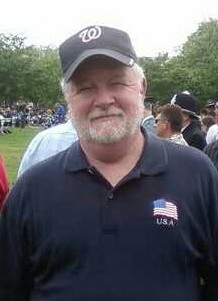 Friday morning, PSWA President John Schembra officially opened the conference. In honor of law enforcement officers who have lost their lives in the line of duty, award-winning poet Joe Haggerty (pictured) read a special tribute poem, followed by a moment of silence (another of Joe’s works below). John then gave out this year’s PSWA Appreciation Awards to some stand-out individuals who help make the PSWA such a successful organization: Mysti Berry, Bob Calkins, George Cramer, Joe Haggerty, and Barbara Hodges. In a highly emotional moment, a special award was presented to Marilyn Meredith to recognize the contribution of her late husband, Hap Meredith, who did so much for the organization over the years.
Friday morning, PSWA President John Schembra officially opened the conference. In honor of law enforcement officers who have lost their lives in the line of duty, award-winning poet Joe Haggerty (pictured) read a special tribute poem, followed by a moment of silence (another of Joe’s works below). John then gave out this year’s PSWA Appreciation Awards to some stand-out individuals who help make the PSWA such a successful organization: Mysti Berry, Bob Calkins, George Cramer, Joe Haggerty, and Barbara Hodges. In a highly emotional moment, a special award was presented to Marilyn Meredith to recognize the contribution of her late husband, Hap Meredith, who did so much for the organization over the years.
Our first Featured Speaker was James L’Etoile who has worked in corrections his entire adult life and was the warden at a maximum security prison. He presented an informative and chilling session on life behind bars.
Our first panel was “The Pluses and Perils of Writing a Series.” Panelists gave tips on how they keep a long running series going, addressing such issues as whether characters should age realistically or be frozen in time. Panelists were Marilyn Meredith, Frank Zafiro, Bob Doerr, Sally Handley, and Peg Roche, and I moderated.
Next, a group of law enforcement professionals talked about building a solid case, including obtaining search warrants, interviewing suspects, and what TV and the movies get wrong. The panel was moderated by Thonie Hevron, with panelists Mike Brandt, Joe Haggerty, Bill Powers, Albert vande Steeg, and Joshua Lee.
Jo Wilkins of Mystic Publications demonstrated ways authors can check the readability of their prose. Attendees said it was one of the best presentations on writing we’ve ever had.
What followed was the panel, “Expanding Your Horizons and Improving Your Writing.” Writer’s groups, beta readers, blogging, podcasts, and AI were discussed by panelists Ellie Oberth, Colin Conway, George Cramer, Barbara Hodges, and John Schembra under the watchful eye of moderator RJ Beam.
At our next panel, “Armed and Dangerous: Doing Someone In, Permanently,” panelists Steve Ditmars, Dave Freedland, Jim L’Etoile, Janet Greger, and Gloria Casale gave us the lowdown on all types of weapons (including poisons) and the effects they might have on a victim’s body. Moderated by Steve Scarborough.
As we closed down this first official day, a number of attendees went to our annual “First Timers’ Dinner.” I was too bushed to accompany them, but I was grateful for no late-night calls to bond anyone out after their night of revelry.
Saturday Sessions
Saturday started off with a presentation by former FBI agent and police officer Pete Klismet, who literally wrote the book on criminal profiling and taught it at the FBI Academy. He described a real-life murder case that unfolded as suspensefully as an episode of Murder, She Wrote. Everyone was enthralled as Pete finally revealed the murderer’s identity.
Our annual publisher’s panel provided the inside scoop on the current state of the publishing industry. Guests included Mike Bray and Rachel DelGrasso of Wolfpack/Rough Edges Press, Jennifer Hendricks (Formerly of CKN Christian Publishing Press), Jo Wilkins (Mystic Publishers), and Barbara Hodges (representing Independent Publishing). It was expertly moderated by Thonie Hevron.
Next R.J. Beam gave an awesome presentation about modern CSI equipment and methods. The audience was mesmerized as R.J. showed advanced technologies for collecting fingerprints, DNA samples, and other crime scene evidence. (Our thanks to his boss in Wisconsin who let him bring some “police toys” for demonstrations.)
The redoubtable John Schembra moderated “Managing Mayhem and Keeping Things Under Control When All Hell Breaks Loose.” Panelists Dave Freedland, Robert Haig, William Soldato, Bob Calkins, and Jim L’Etoile gave us the lowdown on controlling situations that risk becoming unmanageable.
Writing nonfiction requires presenting facts in a way that keeps readers engaged. Often it recounts actual events. I moderated panelists Jim Altfeld, John Buck, Joshua Lee, Bill Soldato, and Mike Brandt, who gave us the benefit of their non-fiction writing experience.
Frank Zafiro then took panelists Victoria Weisfeld, Barbara Lloyd, Kelli Peacock, Dean
Cobet, and Jim Christ through “The Art of Revision.” And it is an art!
The prestigious Writing Competition Awards, hosted by Barbara Hodges, were celebrated Saturday night (see Barbara’s article above).
Sunday Sessions and Farewell
Sunday’s opening panel was “Crafting the Story.” Moderator Kelli Peacock asked panelists Ann Parker, Jim Christ, John Bluck, Marilyn Meredith, and Mysti Berry to describe their considerations when writing a novel set in the distant past, recent past, or future. Even authors who delve into the past only in flashbacks could find useful information here.
Moderator for our panel on “Blogging, Podcasts and Other Promotional Tactics” was Colin Conway, and we received helpful tips from panelists Frank Zafiro, Camille Munichino, Ann Parker, Mysti Berry, and George Cramer.
Our final panel of the conference was one of the best. They say “you can’t judge a book by its cover,” but is that true? In “Getting Things Covered,” moderator Thonie Hevron and panelists Kelli Peacock, Barbara Hodges, George Cramer, Janet Greger, and John Schembra discussed the importance of cover designs, author photos, etc., in attracting a reader’s attention.
Prize drawings had been scheduled during breaks throughout the conference, and many really swell prizes were given out. Appreciation to all who donated prizes, especially to Camille Minichino, who provided one of her wonderful miniatures. But now it was time for the Final Prize Drawing. All the attendees’ names were in the basket and John Schembra drew the lucky winner of a free registration to next year’s conference. The ever-popular and gracious Steve Ditmars will be PSWA’s guest in 2024.
All that was left to do was close down the bookstore, dismantle the equipment, and clean up the room. Some people lingered conversing, laughing, and hugging for a time, but eventually all the mundane tasks were completed and all the goodbyes had been said. When I walked out of the room I felt my usual mixture of relief and sadness. It had been a wonderful conference.
My thanks to all who helped and to all who came. I look forward to seeing you next year. Let’s do it again!
The 2023 Conference: Member Feedback
Another Newbie who thought the conference was great—from the people I met to the knowledge obtained.
Bill Soldato
My experience at this year’s conference was fantastic, and I’d like to thank Board Members, especially Mike Black, for a great experience. I heard nothing but positive comments regarding the poem I read at the opening. (A copy of the poem was in the conference program. If you’d prefer an individual copy, please email me at gudgerray@aol.com and I will gladly email one back to you. If you want it signed, I’ll need your home address.)
The panels were great, but my favorite presentation was Jim L’Etoile’s on prison life. Naturally, I also enjoyed the award ceremony. Winning five awards was totally unexpected. Competing against such great writers is a real challenge. I can only guess that there just weren’t that many entries in the categories I entered. Either way, I am so grateful and humbled by being chosen.
Lastly, on Sunday I was slated to read a wonderful story written by Keith Bettinger, “The Sapling,” which was also printed in the program. I was very nervous about reading the story and told Mike I might bow out. About 4 am Sunday morning, I had a great idea! At breakfast with Frank Zafiro and Colin Conway, I asked if they would read it with me. To my great relief, they agreed. I wanted to divide the story into four parts, so I need a fourth reader, and Jim L’Etoile accepted. At the risk of tooting my/our own horn, I think the reading turned out very well. Keith said he thought it was a very good presentation, and it was his work, so I figure we done good. As always, I look forward to next year’s conference!
Joseph B. Haggerty, Sr.
This past conference was the best yet. Excellent speakers and informative panels kept us all busy taking notes. The family reunion feeling was enhanced by the wonderful addition of all the new faces this year. In fact, I felt like I met amazing new members who will serve the membership well into the future.
Thonie Hevron
Always an informative experience, but the heart of the conference for me was the chance to meet other members and learn about them.
Frank Scalise
But enough about the program, let’s talk about the FOOD! A stellar job by the Orleans. Your newsletter editor says it was the best conference food she’s ever been served, and she’s been to hundreds!
Vicki Weisfeld
The PSWA Conference was Wonderful, But….
From Marilyn Meredith
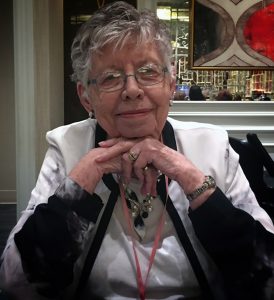 Of course I was thrilled to be there. Nothing like seeing long-time friends and meeting new folks.
Of course I was thrilled to be there. Nothing like seeing long-time friends and meeting new folks.
The presenters were great and so were all the panels. As the conference progressed, I began to realize something. At one time, I knew about and had embraced all the new technology as it came along, but now I’m woefully behind.
Having been around for many years, when I began writing, I’d make copies using carbon paper. I progressed from a portable typewriter to a classy electronic version. When personal computers became available, I bought a Kaypro from a friend who taught me how to use it and the floppy discs it required. As computers evolved, I kept buying new ones.
My first portable phone I kept in the car—it was the size of a brick. I had one of the first Blackberrys and loved it. When the iPhone came out, I could hardly wait. I signed up for the Internet and quickly learned how to navigate it. I was one of the first to have a personal blog.
I knew e-books would become an important part of publishing, but when I talked about them at conferences and conventions, I was often booed or ridiculed. I had a Rocket E-book to read e-books on, and several of my own novels were published as e-books.
Now, time and technology have moved on. I’m afraid I haven’t used any of the new tools panelists talked about to help with editing their books. I knew next to nothing about another hot topic: Artificial Intelligence, or as everyone called it, AI. I learned there are both image generators and text generators. Oh my!
Frankly, I think I’ll sit back and let this new generation of writers move along without me. And I’ll have so many books to look forward to reading.
I’ve ended both of my mystery series, and if I have enough time left, I plan to work on a memoir of my childhood during World War II—and maybe a YA novel set during the same period.
This conference was the best one ever.
Marilyn is the author of the Deputy Tempe Crabtree mystery series and the Rocky Bluff P.D. series, written under the name F.M. Meredith.
Member News
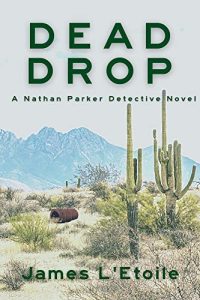 James L’Etoile’s Dead Drop won the Silver Falchion award for Best Investigator Novel at the Killer Nashville conference in August. He gave an excellent presentation to Mystery Writers of America’s Southeast Chapter (reprised at Killer Nashville) on “Capturing the Criminal Character for Your Book.”
James L’Etoile’s Dead Drop won the Silver Falchion award for Best Investigator Novel at the Killer Nashville conference in August. He gave an excellent presentation to Mystery Writers of America’s Southeast Chapter (reprised at Killer Nashville) on “Capturing the Criminal Character for Your Book.”
Shauna Washington’s story “Bayou Blues” made the September/October cover of Alfred Hitchcock’s Mystery Magazine. While many of us struggle to get into this magazine at all, it’s the fourth cover appearance for her! Read an excerpt here.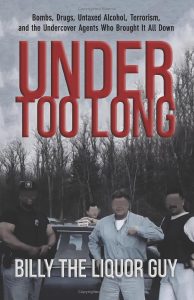
John Schembra is 30,000 words into his ninth book, tentatively titled A Suspicious Death, though he’s sure that will change by the time he’s done with it. It’s about a serial killer of women, skilled at making the deaths appear to be an accident or suicide. The protagonist, Detective Sergeant Louise (Louie) Princeton of the Richmond (Ga.) County Sheriff’s Office spots some discrepancies in the fentanyl death of the latest victim. To her, it just doesn’t seem like suicide. John provides a bit of a teaser, saying, “the killer becomes enamored with Louie and is stalking her. And so the story goes.”
Vicki Weisfeld’s short story, “A Pearl of a Girl” was published in the Bouchercon 2023 anthology, Killin’ Time in San Diego.
Bill Soldato reports that since his novel Under Too Long (by Billy the Liquor Guy) received its award in the PSWA Writers’ Competition, sales have increased! So much so, that it is ranked among the top 40 books in the Mid-Atlantic states and among the top 200 on the east coast. He admits these rankings can change a lot with just a few sales, but they were never previously that high. He has book signings and radio interviews lined up for the fall from California to New York. His publisher is delaying publication of his second book, Beyond Billy the Liquor Guy, to make time for promotion of the PSWA winner.
New Books!

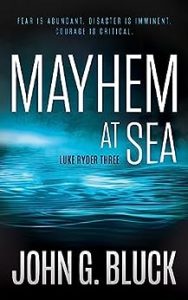 In August, member John Bluck’s new award-winning thriller, Mayhem at Sea, was published by Rough Edges Press. It’s the third in the Luke Ryder series, and, in this latest adventure, Deputy Sheriff Ryder is looking forward to some relaxation time aboard an Alaska-bound cruise ship with his girlfriend, a former escort named Layla. But when the ship is hijacked by pirates, his expectation of peaceful whale-watching turns into a fight for not just his and Layla’s lives, but for the lives of everyone aboard.
In August, member John Bluck’s new award-winning thriller, Mayhem at Sea, was published by Rough Edges Press. It’s the third in the Luke Ryder series, and, in this latest adventure, Deputy Sheriff Ryder is looking forward to some relaxation time aboard an Alaska-bound cruise ship with his girlfriend, a former escort named Layla. But when the ship is hijacked by pirates, his expectation of peaceful whale-watching turns into a fight for not just his and Layla’s lives, but for the lives of everyone aboard.
Mayhem at Sea placed second in its category (long form, unpublished) in the PSWA Writer’s Competition this year. Shortly thereafter, the New York Post recommended the series’ first book, Death in the Holler, as one of “20 action-packed books to bring on vacation this summer.”
For more information about Bluck and his work, visit his website, by clicking here. Or his webpage hosted by his publisher, Rough Edges Press, by clicking here. Also, you can subscribe to John’s email list here.

 This November will see publication of Frank Scalise’s new short story collection, The Last Cop & Other Stories, will be published under his pen name, Frank Zafiro. It’s a standalone and includes a few flash fiction stories written some time ago. As an Independent Publisher, he offers some helpful advice on the process.
This November will see publication of Frank Scalise’s new short story collection, The Last Cop & Other Stories, will be published under his pen name, Frank Zafiro. It’s a standalone and includes a few flash fiction stories written some time ago. As an Independent Publisher, he offers some helpful advice on the process.
“A lot goes into any indie publication,” he says, “and that’s not including the creative and editorial effort in completing the work itself! Once that’s ready to go, you have to choose a title, a cover theme and the artist to bring that theme to life, format the book for ebook and print, and prep it for audio production.
When the work is a story collection, there is the additional issue of ensuring you have the rights to the story. Stories first published elsewhere, usually in anthologies, generally involve contracts giving the original publisher exclusive rights to publish it, usually lasting one year. “I had to delay publication of this collection so that one of the stories I wanted to include could exit its exclusivity period,” Scalise says.
Some of his decisions turned out to be easier than usual on this project. In the past, he’s always used one of the included stories as the volume title. The Last Cop had the right ring to it, he thought. “Plus, I had an image in my head from the opening scene of that story—an aging cop on a nearly obsolete subway, gripping the rail as the car hurtles along.” He believes the cover artist more than delivered on that visual. Scalise formats the ebook early in the process—sometimes when creating the first draft—and does the print formatting later. He uses Microsoft Word for this, which he says is pretty robust (although he’s toying with a transition to Atticus).
Of course, when you reprint, there’s the temptation to revise. After all, it feels like a second crack at the story. “I confess openly to fixing any typos and may glance away without answering if accused of the occasional buff or polish, but for the most part, I leave them as they were.”
Audio is its own entire discussion, and he produces many of his own titles. For The Last Cop & Other Stories, he’s narrating the opening and closing credits and probably one of the stories. Separate narrators will be chosen who fit each story. For his previous collection, Sugar Got Low, seven different narrators read the 13 stories. “So even though the collection has only one author, the audio version feels like an anthology,” he says.
“Putting together a story collection lets me revisit old friends. Each of the stories is from a particular place and time in my writing journey, so working with them again is a little nostalgic, even if they were written as recently as a year ago.” Several of these stories won awards at the 2022 PSWA conference—Scalise’s first ever. Others were part of anthologies he’s proud of being part of. “And those old flash shorts certainly took me way back.” As we all know, he says, “there’s nothing wrong with a trip down memory lane, as long as it leads you back to the present.”

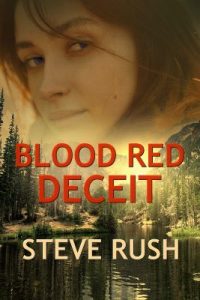 The idea for Steve Rush’s new crime thriller, Blood Red Deceit, developed from his career in forensics and, like a former co-worked commented, grinning, about the book’s protagonist, Ridge Warner, “Of course he’s a forensic pathologist.” Yes, Ridge trained in forensic medicine and became an expert consultant, but expect no cold room full of violent deaths he must autopsy. Fictional characters often want more for themselves, Rush says, and Ridge’s journey led to an unforeseen career detour and this opening paragraph:
The idea for Steve Rush’s new crime thriller, Blood Red Deceit, developed from his career in forensics and, like a former co-worked commented, grinning, about the book’s protagonist, Ridge Warner, “Of course he’s a forensic pathologist.” Yes, Ridge trained in forensic medicine and became an expert consultant, but expect no cold room full of violent deaths he must autopsy. Fictional characters often want more for themselves, Rush says, and Ridge’s journey led to an unforeseen career detour and this opening paragraph:
Life threw changes my way, but nothing like this. This latest event altered my future with fiancée Angel Meade. The blood I donated saved her life. An analysis of my blood exposed an inconceivable truth minutes later.
The story’s major “What if?” question is: What will Angel do with this indisputable certainty? As a pantser, not an outliner, Steve says he deferred to Angel for the answer. “This new ‘truth’ annihilates her future with Ridge, it ignites her scheme to destroy him, and she dons animosity as if it were her favorite pair of sneakers.” With Angel’s reaction, Ridge finds himself at an impasse. He wishes he knew who wants to kill him. He wishes he knew why. He wishes he never learned the answer.
Rush extends gratitude to PSWA members Donnell Ann Bell, Michael A. Black, and George Cramer for their editorial reviews. Also, Donnell has interviewed him about this story and his writing process. Find that here.
Don’t forget! Share news of your new books with the newsletter editor, and she’ll feature them in the next issue! Send them to pswanews@gmail.com.
21 PRAYERS
Two days before the end of the school year
The children and their teachers had no fear
Two classes were combined into one
And two teachers proposed lessons and fun.
Several of the students had made the honor roll
And proud parents praised their children’s goal.
Security measures to keep the kids from harm’s way
but a door was left unlocked on this fateful day.
Evil entered that door bringing death in his hands
horrible deaths that no one understands.
19 young children released their innocent souls
And two heroic teachers will no longer be on the rolls.
Their Savior awaits their entrance to his school
And the devil took the shooter forever to rule.
Law enforcement killed the murderer, but not before
21 bloodied bodies lay still on the classroom floor.
Our prayers go out to the families who lost a child
Whose faces and memories won’t be defiled.
The children who survived will remember with pain
Thinking of their fellow classmates who were slain.
I cried as I’m sure many others did as well
Hard to imagine the loss, hard to imagine the hell.
Let us pray that these innocent lives will show us a way
To protect children from experiencing a day like this day.
“21 Prayers” received the second-place award in the 2023 PSWA Writers Competition, after another Haggerty poem, “A Heavy Price to Pay” was first!
The Writing Craft: Upping Your Game
Writing Mysteries: Ten Tips That Work
From Camille Minichino
Mystery novels make up one of the most popular categories of fiction. The spectrum of crime fiction published today is broad—from the coziest whodunits, where the lady who runs the crafts store solves all the town’s murders, to the most graphic thrillers, where the lives of millions are at stake. Each sub-genre has different conventions, but certain characteristics apply to all: a strong and appealing protagonist, a compelling story with red herrings and interesting twists, and a satisfying conclusion. Here are ten tips to help you write a polished, dynamic page-turner, no matter what your sub-genre.
Tip 1. Find your niche. The best reason for choosing to write a mystery is that you love to read them. Take a minute to analyze your mystery reading habits. Do you prefer hard-edged or soft boiled? Gritty or cozy? Graphic or “fade to black”? A professional detective or an amateur who gets caught up in solving a crime? Being able to pinpoint the sub-genre is critical in selling your book to an agent or publisher.
Tip 2. Nail down the tropes. Read extensively in your sub-genre. Note what works and what doesn’t. Pay attention to details like chapter length and number of characters. How early in the book does the murder take place? When is each new character introduced? Is profanity acceptable? Yes, there’s a formula. Like architects who must start with the basic structure of floors and ceilings, it’s up to writers to add the elements that make their books unique.
Tip 3. Build the character arc. Amateur or professional, a sleuth needs an arc of personal growth that is apart from, but runs parallel to, solving the crime. Maybe he is afraid of heights (think Hitchcock’s Vertigo), but in order to find the last clue, he has to climb to a rooftop. Maybe she thinks ill of a secondary character, but finds out in the course of the investigation that she’s misjudged him and thus learns something about herself.
Tip 4. Motivate your sleuth. Especially if your detective is not a professional, there must be a compelling reason for him to want to solve the crime. But even if your sleuth is a homicide detective or a PI, it’s a good idea to add a personal motive for her passion to bring the killer to justice. Is the victim related to a friend? Is there back story that makes this case important? Will this case help resolve a personal issue?
Tip 5. Beat the reader over the head. Be aware that although you introduced Johnny in Chapter Three, your reader may have gone to Tahiti and back since she picked up your book. Provide a tag line nearly every time you mention Johnny. Remind the reader who he is and what he’s like through action or description. Maybe his bald head picks up light from the lamp; maybe he’s wearing the tie with the gravy stain in the middle of the flock of seagulls.
Tip 6. Delete small talk. Make your dialogue count. Never use throwaway words like “Well,…” or information-free phrases like “How are you?” Instead, you might say, “Do you still suffer from…?” or “When’s your surgery?” Give each character a distinctive phrase or manner of speaking, without going overboard. Use accents sparingly or you’ll annoy the reader.
Tip 7. Mark time well. Pace the story by interweaving all the elements of fiction in every scene: action, dialogue, physical description of the setting, physical description of the characters, internal thoughts and physiological sensations of your point of view character. Spending too much time on one element, such as lumping several paragraphs in a row to describe scenery, will bore the reader and distract from the story.
Tip 8. Layer the crimes. Each suspect should have some flaw that makes him seem guilty of murder, but in the end is a lesser crime. Your sleuth discovers that the victim’s financial manager is an embezzler, but not a murderer; the butler has been skimming from the cookie jar, but he’s not a killer. The murderer will be the last to be revealed, but on the way, your sleuth finds that everyone is hiding something.
Tip 9. Make every scene count. Each scene needs an arc of its own, with a beginning, middle, and end. Each scene must move your story forward. Avoid throwaway scenes that are simply funny or pertain to a romantic thread. Plant an “aha” moment in the line of that joke, or a clue as the date progresses. Everyone, even Cupid, must serve the mystery! Consider also a cliffhanger ending to each scene, as long as you eventually include a payoff.
Tip 10. Make every word count. Use allusions and figures of speech wisely. Choose a theme or metaphor or leitmotif and stay with it. If your sleuth is a scientist, show us her world through metaphors that evoke laboratory smells and equipment. Don’t throw in a reference to Hamlet unless you’ve convinced us that she’s also a Shakespeare buff. Like a beautiful painting, your novel should have a finely tuned palette.
Thanks for this, Camille!
Emotional Writing
From Kelli Peacock
 Every fiction writer should have a goal to develop emotion. Whether writing a short story or a novel, mastering emotion in fiction is a very important skill. This is not an easy task because emotions are complex and complicated, and humans are not predictable. We need to ask ourselves what emotional reaction we want our scene. Readers read to care and if you don’t succeed in making your readers feel, then you fail.
Every fiction writer should have a goal to develop emotion. Whether writing a short story or a novel, mastering emotion in fiction is a very important skill. This is not an easy task because emotions are complex and complicated, and humans are not predictable. We need to ask ourselves what emotional reaction we want our scene. Readers read to care and if you don’t succeed in making your readers feel, then you fail.
One has to look deeply at why and how readers respond to emotion. It’s important to know your genre—genre cannot be ignored. Writers are manipulators. If you master the art of showing and telling emotion then your readers will feel a connection to your characters.
Writers can’t show their characters feelings and expect readers to have the same emotional response. It doesn’t make the reader sad or happy just because your character is sad or happy. What moves you, what’s important to you, what you fear and love and hate informs your characters. Your values come through your characters. Readers love authenticity. We cheer for characters who show admirable qualities—who are courageous, honorable, vulnerable, and passionate.
Today readers want to dive deep into our characters instead of being told what the characters emotional response is. Deep point of view has become the norm across genres. Show, don’t tell, is the rule. Although that is easier said than done. There are two facets of emotion in fiction— conveying emotion in your characters and evoking emotion in your reader. You need to be willing to dive deep into the emotional landscape of both your character and your reader to achieve emotional mastery.
Before we can do that we have to understand the action-reaction cycle. This is important to building believable characters. If our characters come across flat, unnatural, and unfeeling it is probably because our characters don’t react, process, and make decisions as events occur. Readers want to go deep into characters. Readers will be confused, disappointed, or even stop reading your story if the characters don’t have believable reactions.
For every action there is an equal and opposite reaction. The action-reaction cycle is action>reaction>process>decision. Action triggers a series of reactions. Reaction leads to processing. Processing takes time. In real life, when someone says or does something unexpected we don’t immediately answer or react quickly and logically. Get into character when working on a scene. Give the reader time to react by creating beats. End a chapter with action, have a character pause, show tiny details they notice, use short words and short sentences, use one-line paragraphs, and show an expression or gesture. Tension cannot be created by action alone. Readers have to care what happens to the characters. It takes thoughtful effort. Personal style is important but it has to work within your genre.
Three ways to show emotional reaction: 1. Telling what the character is feeling (naming emotions); 2. Showing emotion by body language (bodily sensations and physical tells); 3. Showing what the character is thinking.
Telling what the character is feeling
Telling the emotion doesn’t necessarily make the reader feel what the character’s experiencing. Although there are ways to name emotion effectively, by using language that suggest an emotion but reveals something else. For example, anger is a first-level emotion. It covers for other emotions like fear, anxiety, depression, etc. Try turning the emotion into a metaphor or simile. Don’t default to stereotype. A young character is ideal for naming their emotional response.
When a writer tells the reader via the author intrusion that his character is jealous, it’s out of point of view. A character might name their emotion later in dialogue or later in narrative. Telling emotion is much easier and more believable in fiction when it’s a character naming someone else’s emotions.
Using physical tells to convey emotions
Showing emotions using physical tells, like body language and sensations, can be tricky. Emotion can be felt internally, without any visible sign. The body both reveals and feels emotions. Our bodies often signal what we are feeling—to ourselves and to others. It’s all about what you want your reader to notice. Your character might not be aware of the feeling they are experiencing or revealing through their behavior. Physical tells—strong emotions are felt viscerally by your character. They might also notice signs of similar emotions in other characters. Body language can only go so far to accurately convey a characters emotions. Don’t rely solely on physical tells. Don’t default to cliches or melodrama.
Three facets to showing emotion via body language. 1. What the character observes in others. 2. What the character notices in his own body. 3. What the author shows from outside the character. Be careful of the fine line between point of view and author intrusion in deep point of view. When using body language, make it count. Hint at unexpected emotion. Reveal emotion your character wants to keep hidden. Find ways to trigger emotion in your scene. Have your character note subtle expressions and gestures in others. Remember it’s always about the point of view character. Don’t describe bodily sensations and physical tells in your characters just because you think the reader should know the emotional state of everyone in the scene. We rarely notice our own physical tells. It’s more common that we notice them in others. Just a couple of lines are all that are needed to set the stage.
Showing emotion via your character’s thoughts.
Our objective as writers is to get readers to care about our protagonist. From the start, you have to work hard to build that empathy. Carefully crafting revealing thoughts is the fastest and most effective way to do so.
It’s easier to evoke emotion once readers care about your characters but it’s also not a sure thing. Thoughts produce emotions but emotions also produce thoughts. Emotions lie dormant like sleeping dragons. Thoughts wake them. Emotions are revealed by thoughts in reaction to what is happening in the scene. Slow it down. You may not be able to name exactly what those emotions are but you should know what they feel like when you experience them. Thoughts more than body language convey character. Writers can eavesdrop on their characters thoughts and use that to their advantage. Getting into the characters thoughts helps show the kind of person they are, their longing, their fears, their hopes, their emotional turmoil. It shows how human they are. Action plus thoughts create a strong emotional landscape. You can evoke emotion by telling. But showing thoughts are the most powerful way to reveal character and evoke an emotional response in your reader.
Sometimes we want our readers to feel something else. With some characters, we may not want our readers to empathize. When working on a scene, remember: we often want a different emotional response from our readers than what our characters are feeling. For example, a couple is getting married. It’s the bride’s big day, she is finally getting married after four broken engagements. Everyone in the church is waiting for the bride to walk down the aisle but the reader doesn’t want this to happen because they know there is a bomb in the building.
Think carefully about the emotions you want to evoke in your readers. Why do I want them to feel this way? Pay attention to your own emotions. Find ways to tap into universal feelings, ones that speak to the general human condition. All along the way, a writer must carefully manipulate the reader’s emotions to try to get them to feel what the writer wants them to feel. Action is important in sparking emotional response. Watching what characters do, how they behave, the choices they make, and the conversations they have—all can be powerful triggers. Carefully plan the action in your story for the greatest impact. Be careful what you choose to write about if you don’t want to go there yourself, and don’t create characters in stories that create intense remembrance of experiences.
The purpose of the setup scene is to quickly bond the reader to the character. Regardless of whether you intend for your reader to like, hate, or be curious about the protagonist, that set up scene has to evoke emotion. If you readers don’t care, they won’t read.
Remember Hemingway’s sage advice: “Find what gave you the emotion…Then write it down, making it clear so the reader will see it too and have the same feeling as you had.”
Love Kelli’s line, “Tension cannot be created by action alone”!—Ed.
 Writing from the Heart
Writing from the Heart
From Barbara Hodges
You’ll find a section on writing with emotion in Barbara Hodges’ writing basics ebook, Writing From The Heart. (Find it here on Google Books.)
In addition, the book includes chapters on creating setting, dynamic characters, and believable dialog; choosing a point of view; plotting (or pantsing); professional editing; and promoting and marketing.
By the way, she notes that Google Books is another way for indie authors to publish ebooks. If your ebook is in epub format, for a limited time you can have it made into an audio book for free, she says.
Lay that pistol down, Babe. Lay that pistol down.*
Grammatically Speaking … Lie vs. Lay
By Michael A. Black
In view of our recent flurry of listserv posts concerning grammar, I was asked to resurrect a column I wrote a few years ago for the PSWA newsletter. I originally wrote it under the nom de plume, Professor X, and my buddy, Ron Corbin, wrote as Professor Y. We’d hoped to have a bit of fun and also generate bit of a mystery about our “secret identities,” but as it turned out, not even Lois Lane was interested. Ron and I shared some observations about grammar and how language changes and evolves. Here’s the one I wrote explaining everybody’s favorite trickster verbs, Lie and Lay.
Ah, those pesky little verbs, to lay and to lie … They crop up here and there in our writing to cause bumps in our prose like potholes in the roadway after a spring thaw. Let’s take a look at the difference between them, and figure out how to avoid those grammatical ruts.
First, we need to provide a bit of background. In English, verbs are categorized as transitive or intransitive. A transitive verb, for lack of a better word, is an action verb. By its very nature, the described action is transferred to something. Thus, a transitive verb requires an object, a direct object, onto which this action is conveyed. Let’s look at an example.
Tom hit the ball. In this instance, the subject, Tom, is performing an action, hitting, on the object, the ball.
If a transitive verb transfers the action to a direct object, it stands to reason that an intransitive verb does not, right? An intransitive verb expresses action that has no object, such as:
Jack smiled. Or, The river ran through the valley.
I know what you’re thinking: does a verb have to be one or the other? Actually, some verbs are always transitive (destroy, send, forbid), and some are always intransitive (tremble, chuckle, happen); however, most verbs can function as either transitive or intransitive as:
The teacher explained the lesson, which is transitive, versus
The teacher never explained, which is intransitive.
Are you following me? Or are you way ahead of me? Or are have you quit reading out of boredom?
Okay, let’s bring in our two problem verbs, to lay and to lie.
Basically, the difference is simple. To lie means to recline in a recumbent position or remain in a lying position. Its principal parts are lie, lay, (have) lain, (is) lying. To lay means to put or to place something. Its principal parts are lay, laid, (have) laid, (is) laying.
Since lay is a transitive, or action, verb, it requires that this action be transferred to a direct object. Lie, being intransitive, expresses an action in itself, thus, it does not require a direct object. When each verb is conjugated, confusion sometimes results. Jack was laying (transitive) bricks in the patio, while Jill was lying (intransitive) on the lawn chair. After Jack had laid the bricks, Jill realized she’d lain there for over an hour.
So, we can lay bricks, blame, or our cards on the table, while the birds laid eggs yesterday. Things get a tad trickier with lie, in that we might feel compelled to lie down now, although we lay down yesterday, and have lain down in the past week.
Before the intervention of grammarians, this distinction was practically nonexistent until the early part of the nineteenth century. We may be moving toward using the two verbs interchangeably again, but for the moment, the distinction remains in place, often with hilarious results.
Even our past presidents have not been immune. Harry S. Truman once said, “I don’t want anyone to lay down on the job.” At an address at Arlington National Cemetery, Bill Clinton
remarked “Remember why many of these people are laying in these graves.” And George W.
Bush once told an audience that the power of this country “lays in the hearts and souls of
Americans.” But we shouldn’t be too critical of our chief executives. After all, they were our
Commanders-in-Chief, not our Conjugators-in-Chief.
Editor’s note: I think part of the confusion is that the present tense of “to lay” and the past tense of “to lie” are both “lie.” Personally, I look it up every time. Here’s a bit from a PI thriller published September 5: “We could no longer see where we entered, and what lied ahead seemed equally infinite.” Wow! More evidence of the disappearance of editors. Of course, the reason to care about these refinements is that SOME of your readers will know the difference, and a faux pas like that one with propel them right out of your story.
*Apologies to Al Dexter
Publishing Tips and Travails
Free For All
From Michael A. Black
Emily Harstone at Authors Publish has released the fully updated 2023 Guide to Manuscript Publishers, with detailed reviews of 280 traditional publishers that accept unagented submissions. Here’s a link for obtaining a Free Copy! But act fast. Limited numbers. Or, sign up for the Authors Publish newsletter and get a listing of publishing opportunities every week by email. I’ve found a few short story markets there myself.
Check This Out!
From the Authors Guild Listserv
Here’s a link to a book pirating web site, where your books may be appearing unbeknownst to you and, most likely, without compensation to you. I looked up Jim L’Etoile’s Dead Drop and—yes—there it was! I don’t know how much good it will do, but at the least, if you find your books there, let your publisher know.
And Check This Out Too
From John Bluck
John reports that he googled his novel, Death in the Holler, and found that it’s available to prison inmates on this website, which specializes in books for prisoners (my book is there, too). You may or may not care whether the content of your book is available to people in prison, but you might want to know whether it is.
Editor’s Turn
Retirement of “A Cop’s Cop”
The retirement of Lieutenant William Sean O’Toole (I wonder whether he’s Irish?), commander of the Bronx Homicide Squad received a nice encomium by Paige Williams in the “Talk of the Town” section of The New Yorker dated 24 July. Some of you may have known him. The piece describes O’Toole’s long career at Fort Apache, as his precinct house was dubbed in the city’s worst days. He and his detectives closed about 75 percent of their cases, the article said. It ended by describing a ceremony familiar to most of you, but quite moving for us civilians too. When he left Fort Apache for the last time, wearing his dress blues, an honor guard flanked him. A Bronx Homicide sergeant held a police radio to a microphone and let the crowd listen as a dispatcher read O’Toole into retirement, thanking him for his 43 years of dedicated, honorable service to the Department and the city’s citizens. Bagpipes played. “Colleagues crowded the barricaded street, and Timothy McCormack, the deputy chief, tearfully said a few words, calling O’Toole “a cop’s cop.” I’ll bet he has some stories to tell! Wonder if he plans to write something? PSWA membership recruitment team, take note!
“This tree of life is dedicated to all men and women of New York State who labor to preserve life through Emergency Medical Services. A special star of life has been placed on this tree in memory of each who has paid the ultimate price in an effort to save others”
Emergency Medical Services Memorial, Albany, New York, Capitol Grounds
